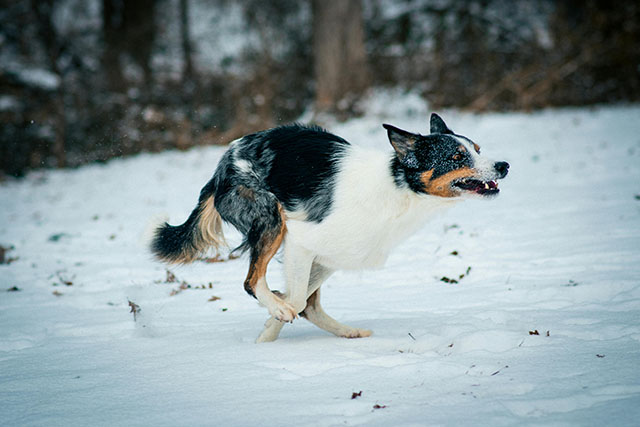Have you ever noticed your furry friend curling up in an unusual position and wondered if it’s more than just a quirky habit? Dogs, like humans, have their own unique ways of communicating discomfort or illness, often through subtle changes in behavior or habits, including how they choose to rest and sleep.
Learn the various dog sleeping positions when sick, what they might mean, and how understanding these positions can give you deeper insights into your dog’s health and well-being. Understand the silent messages of our canine companions, ensuring they receive the love and care they need when they’re feeling under the weather.
Do Dogs Sleep When They Don’t Feel Well?
Yes, similar to humans, dogs may sleep more when they’re not feeling well. Increased sleeping is a dog’s natural response to illness or discomfort, as rest helps their body to recover more efficiently. If your dog is sleeping more than usual, it could be a sign that they’re dealing with an underlying health issue or simply feeling under the weather.
It’s essential, however, to observe additional signs and changes in behavior because while more sleep can signify recovery, it could also indicate something more serious requiring veterinary attention.
What Position Do Dogs Lay in When in Pain?
When dogs are in pain, they often adopt specific positions that can be indicators of discomfort. Among these positions, a few common ones include:
The Prayer Position
Dogs in pain, especially with abdominal issues, might stretch their front legs forward, lower their chest to the ground, and keep their rear end in the air. This position is known as the prayer position and can indicate discomfort or pain in the abdomen.
The Curled Up Position
While many dogs curl up to sleep comfortably, a dog that is persistently curling up into a tight ball might be doing so to conserve body heat or protect its abdomen because it’s in pain.
Lying Down with a Stretched Out Rear Leg
Dogs experiencing pain, particularly in the hips or hind legs, may lie down and stretch one or both rear legs out behind them, which can be a sign of trying to alleviate discomfort.
Shifting of Weight
Dogs in pain might also frequently shift their weight off sore legs or avoid putting weight on one leg entirely, standing or resting in a position that minimizes pressure on a painful area.
Reluctance to Lie Down
Some dogs may show reluctance to lie down at all, remaining standing, sitting, or pacing instead. This can indicate pain that worsens when lying down, such as certain types of joint or chest pain.
How Do You Comfort a Sick Dog?
Comforting a sick dog involves more than just providing medical care; it encompasses emotional support and adjustments to their environment to help them feel safe and loved. Here’s how you can help your furry friend:
- Create a Quiet and Comfortable Resting Area: Choose a quiet corner away from the hustle and bustle of the house. Using a Deluxe Plush Dog Crate ensures their bed is soft, clean, and warm. You might also add an extra blanket for them to snuggle into.
- Maintain a Regular Routine: Dogs find comfort in routine, so try to keep feeding, walks, and bedtime as regular as possible. This helps them feel secure and less anxious about their environment.
- Gentle Affection: Offer your dog gentle strokes, cuddles, or massages. Consider using the Paws & Relax Turtle-Shaped Pet Massager for added relaxation. However, some dogs might want to be left alone when feeling unwell, so it’s important to read their cues.
- Stay Calm and Positive: Dogs can pick up on our emotions, so it’s vital to stay calm and positive around them. A stressed owner can stress out the dog, which can hinder their recovery.
- Easy Access to Food and Water: Ensure they have easy access to food and water. If they’re not feeling well, they might not have the energy to go far, so keeping these essentials close by is important.
- Soft and Quiet Music: Playing soft, calming music from Wholetones can provide a soothing environment for your sick dog. Studies have shown that certain types of music can calm anxious dogs and possibly aid in their recovery.
- Consult Your Veterinarian: Lastly, make sure to follow any advice or treatment plan your veterinarian provides. They might also offer additional tips on how to comfort your specific dog based on their condition and personality.
What are 3 Signs Your Dog is Suffering?
Understanding the signs of suffering in dogs is crucial for providing timely care and comfort. Here are three indicative signs:
- Change in Eating Habits: A sudden lack of interest in food or a significant decrease in appetite can be a sign your dog is suffering. Dogs who feel unwell often show less enthusiasm for meals, treats, or even their favorite snacks.
- Unusual Vocalizations: Increased vocalizations such as whimpering, growling, snarling, or howling can indicate that a dog is in distress or pain. These sounds, especially when out of character for your dog, warrant closer attention and possibly a consultation with a vet.
- Altered Social Behavior: Dogs suffering might become more withdrawn or, conversely, more clingy than usual. A dog that usually enjoys interaction but suddenly prefers solitude or seeks constant companionship when previously independent may be signaling discomfort or pain.
What Can I Feed a Sick Dog?
When your dog is feeling under the weather, it’s essential to adjust their diet to help them recover more comfortably. Easy-to-digest foods are key for a sick dog, as they can help prevent further stomach upset and provide the necessary nutrients for recovery.
Bland diets, including boiled chicken without the skin, white rice, and plain pumpkin (not the pie filling), are gentle on the stomach and can be very soothing. Keep portions small and frequent; feeding your dog small, manageable amounts of food can help maintain their energy levels without overwhelming their digestive system.
Always ensure fresh water is available to keep them well-hydrated. It’s also crucial to consult with your vet before making significant changes to your dog’s diet, especially if they’re experiencing severe symptoms.
Understanding and Caring for Your Ailing Canine Companion
In recognizing and responding to the distress signals sent through their sleeping positions, we deepen our bond with our furry friends, ensuring they feel loved and supported, especially when they’re not feeling their best.
While knowledge of these positions and signs is a powerful tool in your caretaking arsenal, consulting a veterinarian is crucial when your dog shows lasting changes in behavior or signs of pain.
Trust in the bond you share with your pet and use these insights to provide the best possible care. After all, a healthy dog is a happy dog, and every moment of comfort we provide strengthens the love and loyalty that define the beautiful relationship between dogs and their human families.
Jessica is a veterinary medicine student who is passionate about animals. Living with her cherished dog, Milo, deepens her understanding of the human-animal connection, enhancing her empathy as a future veterinarian.
Jessica’s concise articles reflect her dedication to improving the lives of animals and those who care for them, making her an inspiring figure in the pet care field.







